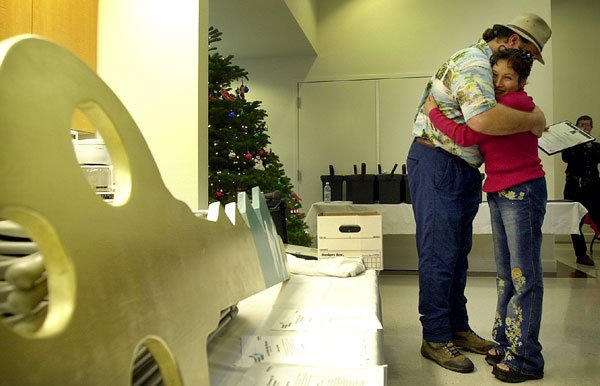
Gilroy—Gilroy families over-billed for property taxes for as many as 28 years will get refunds that could total more than $7 million, and Santa Clara County’s cities and schools will pay for the fiscal fiasco, officials said this week.
County Assessor Larry Stone put part of the blame on Gilroy officials and South County Housing (SCH), the nearly defunct, nonprofit affordable housingdeveloper that built 220 of the affected below market rate (BMR) homes in six subdivisions built from 1987 through 2013.
Most—102 of the homes—are in the sprawling, mixed-income Los Arroyos development, which included sweat-equity homes built by very low-income families themselves.
Low-income BMR buyers get an affordably priced home but it comes with restrictions: they cannot be rented out and, if resold, must be priced below the market price to ensure it stays affordable to lower-income families for years.
The city of Gilroy has responsibility for ensuring restrictions are honored and is now investigating what happened and if restrictions were followed, according to City Administrator Tom Haglund.
In the Gilroy case, the county assessor was not notified that the homes were BMR and should therefore be assessed at below the market rate for a substantial tax savings.
When asked who dropped the ball, Stone said, “There were a number of mistakes here. South County Housing originally should have notified the assessor that these were BMR units. I am not suggesting anything sinister. I am not sure they were aware there was something they should have done,” he said.
“It’s the same with the city of Gilroy. It would have avoided this whole thing if they had [notified the assessor],” Stone said, adding, “this shouldn’t be allowed to happen, when people engage in creating these kinds of below market rate programs they should be required to let the assessor know.”
Dennis Lalor, president and CEO of SCH, said in response that his organization has had discussions with county officials in the past when individual BMR homes inadvertently received a higher valuation.
“In all the jurisdictions we’ve worked in, we’ve had conversations with the assessors’ offices to make sure, if the homeowner brought that issue to us, or it’s resold, we’ve argued the property taxes should reflect the restricted value,” he said.
“We go through a lot of work to make sure owning a home is less expensive of an option for a lot of families. We made this option available. Could South County Housing have done something differently? Perhaps. The county, or the city could [too]. Probably the person most aware of it is the homeowner.”
Lalor said SCH had no agreement with the city about who should notify the assessor and that he was “surprised” the overbilling went on for so many years.
“That’s shocking that people would overpay $7 million and nobody would pick up on it. I have no idea how they have the ability to come up with that number,” Lalor said.
Stone said the California Assessors’ Association and Habitat for Humanity, which he described as “clearly more sophisticated and more experienced” than SCH, would like to see such a law enacted but the League of California Cities has rejected suggestions it support legislation. His office continues to advocate, along with Habitat for Humanity, for the legislation.
Starting in 1979, South County Housing built more than 3,000 housing units, most BMRs, in Santa Clara, Santa Cruz, Monterey and San Benito counties. It also offered homeowner training for the families, some of them non-English speaking. It typically also asked those buyers to sign a document acknowledging the rules had been explained.
Stone said his office has processed BMR assessments for years and has never had this issue come up.
While he believes SCH or the city should have notified his office, “There is no legal obligation” for them to do so and that, ultimately, the responsibility is with the homeowner, he said.
Marie Fuentes, assistant county assessor, suggested the matter goes beyond legal responsibility, particularly because a “large number” of the buyers had limited or no English language abilities.
“I think it’s their [the city and SCH] fiduciary responsibility to explain to all of [the buyers] the ramifications of home ownership and their responsibilities,” she said.
Lalor said, “There’s about four or five layers of people between me and the homeowner. [With] more than a dozen projects over the course of 20 years or more, each had its own specifics and different training by different people.”
Indeed, all homeowners in the county receive notices annually from the assessor’s office detailing assessments and taxes and inviting recipients to contact the assessor if they think the figures are wrong. None of the Gilroy BMR owners did that, according to Stone and David Ginsborg, deputy assessor.
The assessor’s office by law is not permitted to go back more than four years in determining overbilling, Ginsborg said. It recommended, sought and received special permission in this case from the Santa Clara County Board of Supervisors to make homeowners whole for all the years of overbilling, at this point up to $7 milion, he said.
Santa Clara County Controller-Treasurer Alan Minato told homeowners in a Sept. 24 letter that refunds for the last three years have been mailed. The remaining overassessments “are more complicated and a plan on how to proceed is currently being developed,” he wrote.
Minato told the Dispatch that refunds so far total $636,206.11, with $24,000 of that interest at 3 percent. But that represents only three years and four of the subdivisions, he said.
The total refund amount could exceed $7 million, he said, and it will come out of property tax disbursements that otherwise would go to tax-funded entities including the cities of Gilroy and Morgan Hill and school districts.
The Gilroy Unified School District will not be impacted because the state makes up any projected property tax shortfall, said Alvaro Meza, the district’s finance official.
In Gilroy, revenue officer Irma Navarro said Gilroy will lose $1,781.21 for every $1 million in refunds paid out. The amount in Morgan Hill is $2,000, according to Dat Nguyen, assistant finance director.
In addition to Los Arroyos, Stone identified the subdivisions and the number of homes affected in each as follows: Alexander (Place), 31; Glenbrook, 23; Summerhill, 22; Alderwood, 21; and Laurelwood, 21.
According to the SCH website, those subdivisions were completed in 2009-2013, 1996, 1999, 1997 and 1987, respectively. Los Arroyos’ four phases were completed between 2000 and 2003.
Morgan Hill Times Editor Michael Moore contributed to this article.













